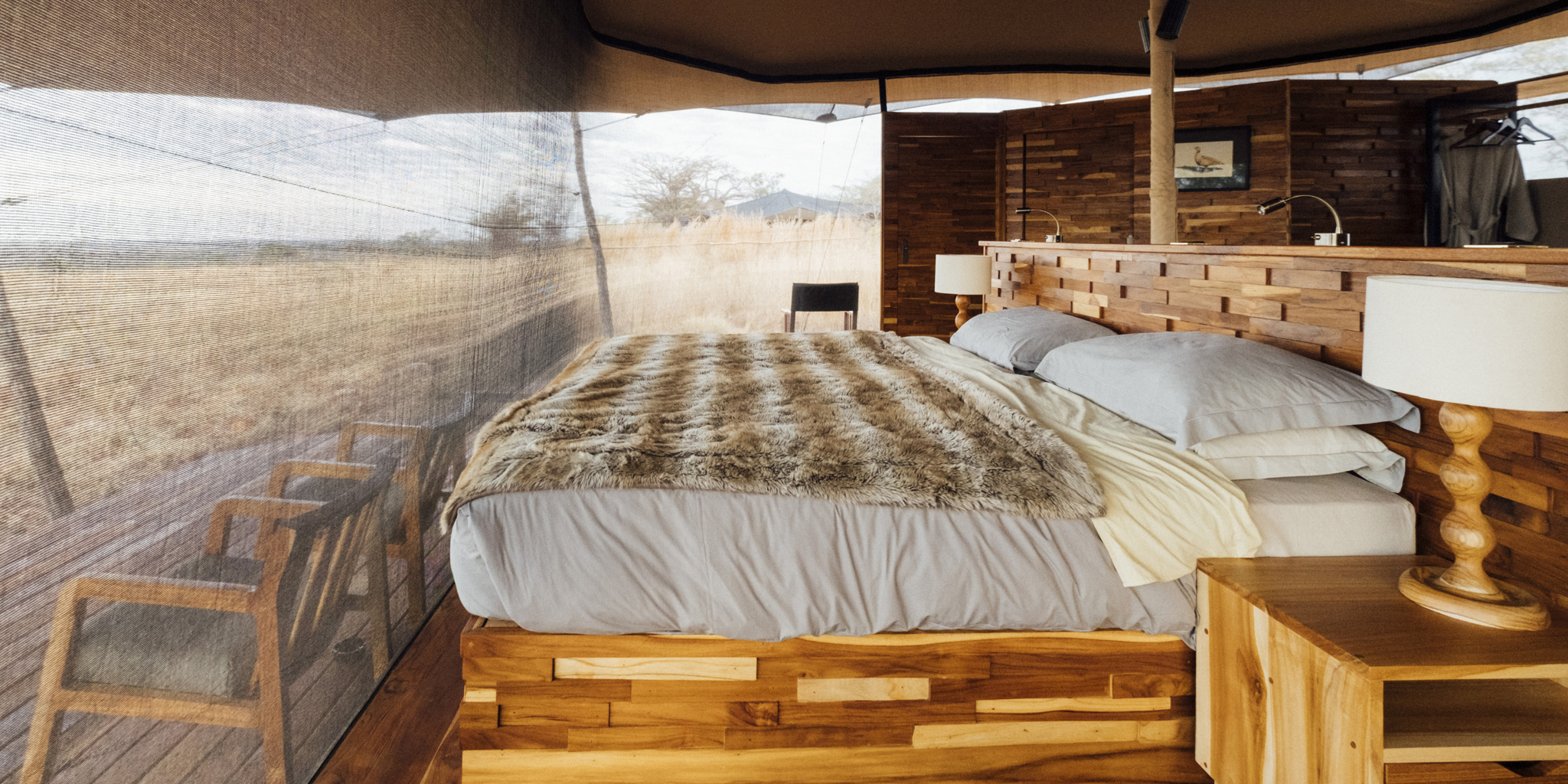OVERVIEW:
Ruaha is Tanzania’s second-largest park at 45,000 square kilometres, and it’s an enclave for some remarkable wildlife. Already a vast wilderness area with not too many camps, allowing you to enjoy a game experience without other vehicles, Usangu Expedition Camp takes this one step further! The Usangu Wetlands have changed dramatically in the last twenty years. The region has been reclaimed from poachers and free-grazing cattle (whose activities were destroying annual water flows into these wetlands), and this rejuvenation culminated in its being made a part of Ruaha N.P. and subsequently a protected area. Amazing conservation work from the Tanzania Wildlife Research Institute and the Douglas Bell Eco Research Station since 2006 has made all this possible. And Asilia’s Usangu is the first camp to open here. One of the leading operators in Tanzania, Asilia runs properties in all major parks, with high-quality guides, food, and service. But this is their most impressively adventurous offering to date!
Usangu offers a pioneering safari experience in a land only recently opened up to visitors, so you can enjoy wildlife watching in true wilderness. The game here has been returning steadily since the wetlands were rescued, and now (as with the rest of Ruaha) you can see strong populations that include lion, hyena, elephant, cheetah, buffalo, giraffe, hippo, wild dog, and crocodile. The area is also home to some rarer species, such as huge herds of topi, sable, the shy roan antelope, and on night drives there’s a chance to see porcupine and aardwolf! As well as Usangu’s full list of safari activities (it’s one of the few places in Ruaha for boating), you can also see first hand how conservation here takes place, through animal collaring and photo traps to monitor numbers. This great new camp certainly gets you into the true African wild – and this stunning, remote location, now transformed into a sanctuary for wildlife again, will only get better and better.
ACCESS & LOCATION:
Usangu is located in the Usangu Wetlands, in the Ruaha National Park. The southern parks of Tanzania offer a beautiful safari option, with the Selous and Ruaha complementing each other perfectly with their unique and contrasting landscapes. Ruaha is famous for its red scorched earth, baobab trees, and sand rivers, while animals here also tend to congregate in vast herds and behave in strange ways! Massive nests of crocodiles, huge prides of lion… Ruaha is a prehistoric paradise. And unlike the Selous, Ruaha also has open plains, so you get cheetah here (who need the space to reach their amazing speeds!). Excitingly, the Usangu Wetlands have also now had regular sightings of wild dog and leopard. The region offers one of the few permanent water sources for miles around, making game viewing here especially good in the height of the dry season.
Usangu is accessed by scheduled light aircraft into Jongomero airstrip, and from here it’s a 2-hour drive to camp. This drive takes the form of a game drive, depending on what game you might encounter along the way! Please note, this is a seasonal camp and open only from 1 June till 31 January.
ACCOMMODATION & FACILITIES AT USANGU EXPEDITION CAMP:
Usangu Expedition Camp sits close to the water’s edge, among miombo woodland that offers welcome shade from the sun. There are six tented rooms. Simple yet elegant, these tents have wide-fronted openings, with a great view of the Ihefu Swamp from your bed (it’s a lot more delightful than its name suggests!). The tents are spacious and well designed, with en-suite bathrooms and flush toilets, built-in plumbing for hot water showers, mosquito nets, comfy beds, battery-charging facilities, and a safe box. Each tent has its own veranda with table and chairs, where you can enjoy your morning coffee and watch resident wildlife wander past. Another wonderful thing at Usangu is their ‘Star Cubes’, which are specially designed to offer a more immersive camping-style experience – you’ll drift off to sleep with the stars above you and be woken by the African dawn chorus. These cubes can be set up either at the Trails Camp for a more adventurous experience, or quite close to your own room – it’s up to you.
The main part of the camp has a lounge, bar, and dining area with comfortable chairs. Great meals are prepared by the camp’s chef (these are sometimes cooked over the open fire), and enjoyed al fresco under the stars. These include a large breakfast and dinner, with lunch often being a light buffet during the heat of the day. There is some Wi-Fi available in camp in the research centre, although speeds in this magnificent wilderness cannot always be relied on! The Douglas Bell Eco Research Station is actually right next door to Usangu, so you will get a chance to meet your neighbours who are doing all this fantastic work in the park. They will discuss with you what you’d like to take part in, and setting animal photographic traps at a place of your choosing is a highlight. It’s possible to plan your trip around exciting events in their calendar, so please chat with one of our safari consultants if you’d like to incorporate this in your stay.
ACTIVITIES AT USANGU EXPEDITION CAMP:
There’s an excellent range of activities on offer here, with the real appeal being the big focus on the conservation side of things, as this is still a developing area. And you get a private vehicle and guide as standard at Usangu, which gives you great flexibility – so if you want to go on a day’s trip farther into the park with a picnic lunch, this is an option!
-
Expertly guided game drives
– Wildlife in the Usangu region includes lion, leopard, elephant, and buffalo (that’s four of the Big Five), as well as kudu, roan, sable, and wild dog. A typical day on safari at Usangu Expedition Camp sees guests going on early morning and late afternoon game drives. Usangu has five biozones and offers many different habitat types, just waiting to be explored. The vehicles are open-sided six-seaters, with removable canvas roofs and sides for unobstructed views. -
Walking safaris
– You can also head out into the bush with an armed guide. As well as enjoying animal tracking and the area’s birdlife, you’ll have opportunities to take a closer look at the reserve’s insects and plant life. The birdlife around the Wetlands is magnificent, with hundreds of ostrich congregating in ways not seen anywhere else! Different levels and distances are available, depending on the ages of your group. Please note, classic walking safari has a minimum age requirement of 12 years. Multi-day walks are possible here, so you can explore even more of the park, but this activity needs to be booked in advance. -
Night drives
– Night drives are a great way to see a different side of Usangu. This is when typically shy wildlife species make an appearance. Heading out with an expert guide, guests will have the opportunity to see leopard, genet, serval, honey badger, civet, and African wildcat on the hunt, as well as bushbabies, nightjars, owls, and bat-eared fox. A great added bonus on night drives here is that you can make use of night-vision cameras! -
Star Cube Fly Camping
– Sleep out beneath the stars! This is a memorable experience indeed. It usually works that your afternoon game drive ends with sundowners near the Trails Camp and you have supper over a fire in the wild. There’s always a guide and armed guard on watch and close by, with the location chosen so animals can be spotted at a distance. Asilia’s new and specially designed Star Cube tents ensure that you maximise your visual and sonic experience of the bush! -
Conservation
– This activity needs a whole section to itself! You really can be as involved as you’d like to be, and it’s amazing to learn from the researchers about what they do. On arrival, guests can take a camera trap and place it in a location of their choosing, usually 10–20 minutes’ drive from camp. On the last afternoon of the stay, guests can retrieve the images to see what the camera has captured. The photos can then be uploaded into the Predator ID Hub at the Douglas Bell Eco Research Station, for identification and tracking. -
Telemetry tracking
– Here, guests can join researchers for a half-day activity of tracking collared animals, using radio telemetry to locate them. Collared species differ over time depending on advancing research, but usually the focus is on key species in the area such as lion, wild dog (yet to be collared), roan, and sable antelope. This often involves use of a helicopter to locate the larger species, meaning the activity needs to be pre-planned with your itinerary – chat to your specialist to make this happen! -
Douglas Bell Eco Research Station
– This is the central hub for all research and conservation efforts that take place within the Usangu Wetlands. Escape the midday heat by engaging with the researchers at the station to learn more about what is taking place. Experiences on offer will vary slightly, depending on which researchers are on the ground at any given time. -
Boating and canoeing
– The boating and canoeing safaris at Usangu are excellent, featuring plenty of hippos and crocs. Boating safaris are a rarity in Ruaha, however, so boating is not available year round. The wetlands flood after the rains to provide boating access, but by the late dry season (approx. August onwards) the marsh has dried and becomes a vast savanna plain for game drives. So the different seasons create a variety of boating conditions, whether that is to follow narrow waterways or to explore large swamps. Elephant are regularly seen in the shallow waters, and the birdlife is fantastic!
*This property is unfenced and located in a wildlife area, so large and potentially dangerous animals do pass through. If you opt to stay here, always be alert when walking around the camp and request for a member of staff to escort you if you have any concerns. Any guest is escorted after dark as a matter of course.
 UK / International
UK / International
 USA
USA
 CA
CA
 Australia
Australia




























